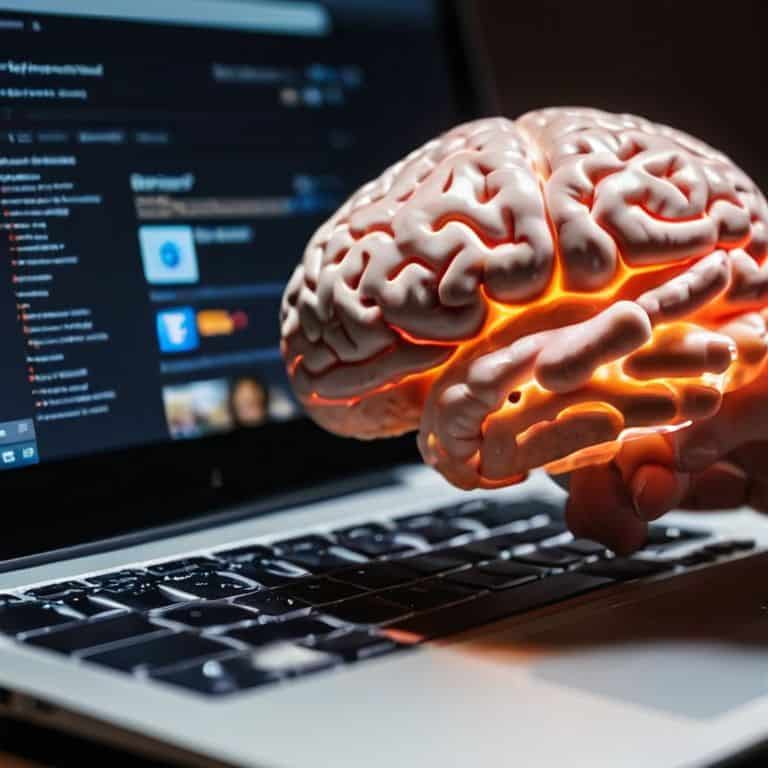I still remember the days when I’d spend hours scrolling through social media, only to feel a mix of emptiness and anxiety afterwards. The constant stream of curated updates and notifications can be a dopamine minefield, triggering a feel-good response in our brains, but what’s really going on beneath the surface? The relationship between social media and dopamine is complex, and as someone who’s spent years studying the effects of chronic stress on the brain, I’m frustrated by the oversimplification of this issue. We’re often told that social media is simply a matter of personal responsibility, but I believe there’s more to it.
As someone who’s been in the trenches, I want to offer you a no-nonsense guide to understanding the impact of social media on your brain’s reward system. In this article, I’ll share my personal story and provide evidence-based advice on how to navigate the world of social media without getting caught in the dopamine trap. I’ll cut through the hype and pseudoscience, and give you the tools you need to take control of your online presence and protect your mental health. My goal is to empower you with practical strategies that are grounded in science, not speculation or marketing fluff.
Table of Contents
Social Media and Dopamine

As I see it, the relationship between dopamine release on social media and our brain chemistry is a complex one. Every time we scroll through our feeds, we’re exposed to a constant stream of information, each post or update triggering a tiny spike in dopamine. This can lead to a state of perpetual distraction, as our brains are wired to respond to these micro-rewards. But what’s often overlooked is the impact this has on our brain chemistry, particularly in the long term.
The social media algorithms and psychology behind these platforms are designed to keep us engaged, often using tactics that exploit our psychological vulnerabilities. By leveraging neuroplasticity, these algorithms can shape our habits and preferences, influencing what we see and interact with online. This can have negative effects on mental health, from increased stress and anxiety to decreased attention span. It’s essential to recognize these dynamics and develop strategies for healthy social media consumption to mitigate their impact.
To achieve a healthier balance, it’s crucial to understand the interplay between our social media habits and brain function. By being more mindful of our online activities and setting boundaries, we can reduce the potential harm caused by excessive social media use. This might involve limiting our screen time, taking regular breaks, or engaging in offline activities that promote neuroplasticity and cognitive well-being.
Algorithms Exploiting Brain Chemistry
As I see it, the real issue with social media and dopamine is how algorithms are designed to keep us hooked. They exploit our brain chemistry, triggering the release of dopamine with every like, share, and comment. This can lead to a vicious cycle of craving and consumption, as our brains become increasingly dependent on the constant stream of notifications and social validation.
The dopamine loop is particularly insidious, as it’s fueled by the unpredictable nature of social media engagement. Our brains are wired to respond to novelty and uncertainty, and social media platforms take full advantage of this by using variable rewards and infinite scrolling to keep us engaged.
Dopamine Release on Social Media
When we’re scrolling through our feeds, every like and comment triggers a tiny release of dopamine in our brains. This can create a self-reinforcing cycle, where we keep checking our accounts, anticipating that next feel-good hit.
The dopamine loop is particularly insidious on social media, as it’s designed to keep us engaged, often at the expense of our mental health.
Breaking the Social Media Trap

To break free from the dopamine trap, it’s essential to understand how social media algorithms exploit our brain chemistry. By acknowledging the _psychological manipulation_ at play, we can begin to develop strategies for healthier consumption. One approach is to set boundaries, such as limiting our screen time or taking regular breaks from our accounts.
By doing so, we can reduce the _negative effects of social media on mental health_, which can include increased stress, anxiety, and decreased self-esteem. It’s also crucial to recognize that neuroplasticity plays a significant role in our social media habits, allowing our brains to rewire and adapt to new behaviors. By consciously choosing to engage in more positive online interactions, we can begin to reshape our brain chemistry and develop more balanced relationships with social media.
Ultimately, the key to breaking the social media trap lies in _mindful consumption_ and a deeper understanding of the brain chemistry at play. By being more aware of our online actions and their impact on our mental health, we can start to make more informed choices and develop healthier social media habits. This, in turn, can lead to a more positive and _empowering_ online experience, one that supports our well-being rather than undermining it.
Mitigating Negative Mental Health Effects
To mitigate the negative mental health effects of social media, it’s essential to establish a healthy balance between online interactions and real-life connections. This can be achieved by setting boundaries, such as limiting screen time or taking regular breaks from social media.
By being mindful of our social media usage and taking steps to regulate our exposure, we can reduce the risk of developing mental health issues like anxiety and depression.
Neuroplasticity and Healthy Habits
As I hit the trails for a morning run, I often think about how neuroplasticity can be harnessed to break free from the social media dopamine trap. By incorporating activities that promote mindfulness, we can rewire our brains to respond to healthier stimuli. This can be as simple as paying attention to our breath, the sounds around us, or the sensation of our feet touching the ground.
By adopting these healthy habits, we can start to build resilience against the constant stream of notifications and likes. I’ve found that foraging for wild mushrooms, a hobby of mine, requires a level of focus and presence that helps to quiet the mind and reduce the urge to constantly check our devices, allowing us to cultivate a sense of inner peace.
5 Evidence-Based Tips to Manage Social Media's Dopamine Trap
- Treat social media as a tool, not a dopamine dispenser: Set clear goals for your social media use, such as staying in touch with friends or staying updated on news, and avoid mindless scrolling
- Implement a ‘2-minute rule’ for social media checks: If you can’t find what you’re looking for within 2 minutes, close the app and move on to reduce endless scrolling and dopamine-seeking behavior
- Use website blockers or app limitations to restrict social media access during certain times of the day or week, allowing you to focus on other activities that bring you joy and fulfillment
- Practice ‘batching’ your social media engagement: Instead of constantly checking and responding to notifications throughout the day, dedicate specific times to catch up on social media, reducing the constant dopamine drip-feed
- Schedule regular ‘digital detox’ days or weekends to completely disengage from social media, giving your brain a chance to reset and reducing the grip of dopamine-driven behaviors
Key Takeaways: Navigating Social Media's Dopamine Landscape
Dopamine release on social media is a real phenomenon, driven by likes, shares, and comments that activate the brain’s reward system, but understanding this mechanism is crucial to avoiding its potential pitfalls
Algorithms on social media platforms are designed to exploit brain chemistry, keeping users engaged for longer periods, which can lead to negative mental health effects if not managed properly through awareness and intentional use
By leveraging neuroplasticity and adopting healthy habits, such as limiting screen time, engaging in offline activities, and practicing mindfulness, individuals can break the social media trap and mitigate its negative effects on mental health, fostering a healthier relationship with technology
The Dopamine Dilemma
Social media’s grip on our lives is less about the technology itself and more about how it exploits our brain’s ancient reward system, turning what should be a tool for connection into a dopamine-fueled trap that we can’t seem to escape.
Dr. Alistair Finch
Breaking Free from the Dopamine Loop

As we’ve explored the complex relationship between social media and dopamine, it’s clear that understanding the underlying brain chemistry is key to developing a healthier online presence. We’ve seen how algorithms exploit our brain’s reward system, triggering a dopamine release with every like, share, and comment. By recognizing these patterns and implementing strategies like neuroplasticity-based habit formation, we can begin to break free from the social media trap and cultivate a more balanced, fulfilling online experience.
So, as you move forward, remember that taking control of your digital life is a journey, not a destination. It’s about embracing the nuances of human connection and community-building in a way that nourishes your mind, body, and spirit. By being mindful of your social media use and prioritizing genuine, face-to-face interactions, you’ll be better equipped to navigate the ever-changing landscape of online platforms and emerge stronger, wiser, and more resilient on the other side.
Frequently Asked Questions
How can I recognize when social media is triggering an unhealthy dopamine response in me?
Pay attention to how you feel after scrolling: do you sense a fleeting high followed by a crash, or an insatiable craving for more likes and validation? That’s your brain’s dopamine system being hijacked. Notice if you’re mindlessly scrolling, comparing, or seeking external validation – these are red flags that social media is triggering an unhealthy dopamine response in you.
Are there any specific social media platforms that are more likely to exploit my brain's chemistry for engagement?
While all social media platforms can be exploitative, research suggests that Instagram and TikTok are particularly adept at hijacking our brain chemistry, thanks to their visually-driven, fast-paced, and often addictive formats. A study published in the journal Cyberpsychology, Behavior, and Social Networking found that Instagram users exhibited increased dopamine release in response to likes and comments, which can create a self-reinforcing cycle of craving and consumption.
Can I still use social media in a way that promotes healthy dopamine release and doesn't harm my mental health?
Absolutely, you can use social media in a way that supports healthy dopamine release. Set boundaries, like limiting your daily use, and focus on meaningful interactions, such as engaging in online communities related to your hobbies, like my own passion for mycology. This approach can help you reap the benefits of social connection without falling into the trap of mindless scrolling.
